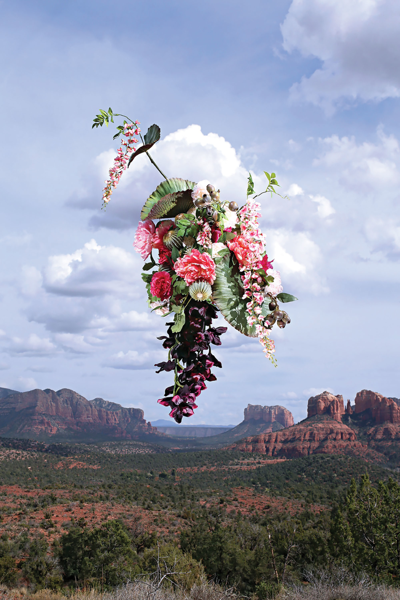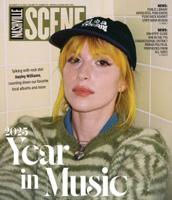
“Altar 34°50’12.9”N 111°49’18.3”W (Dying played forward and then in reverse),” Benjy Russell
In the 1967 Star Trek episode “This Side of Paradise,” the crew of the Enterprise beams down to the planet Omicron Ceti III with a grim mission: to catalogue the remains of a civilization that was destroyed by radiation. But what they find is a verdant land that’s humming with life, where everything and everyone is in perfect harmony, and even Spock falls under a spell that renders the usually stoic Vulcan euphoric. In Benjy Russell’s solo exhibition You’re on new bridges made of home (you found the light in a dark poem) at Wilder, the Tennessee artist presents a radical queer utopia that’s at once reverent and playful.
Here, ornate floral altars yield magical portals. Advanced lighting techniques create surrealist landscapes and portraits that look plucked from dreams. Sex workers appear as goddesses, and butterflies mingle on chainsaws. The installation has taken over Wilder’s sleek new townhouse, and it’s the perfect venue for a midcareer retrospective of Russell’s work and a blueprint for a new, awe-inspiring world.
The first floor, called “Terra,” is grounded in nature. The exhibition opens with one of Russell’s signature ornate floral sculptures. The piece — sitting atop a clear acrylic pedestal to make it appear like it’s floating — is filmed in place, and the film is projected back onto the sculpture, creating an optical feedback loop, or as Russell says, “projecting the infinite.” Optical illusions are at play in other works on the floor. Photos from Russell’s Hazing the Muse series, made in collaboration with Rya Kleinpeter, show angular sculptures that are suspended over natural elements, like a field of yellow flowers and a wooded lake. By using Hollywood lighting techniques and “old magician’s tricks,” Russell says, he creates a surrealistic effect. In another piece titled “Soft Butch,” Russell lights the mouth of a cave in dusty rose and the exterior in electric blue. A fluorescent sign spelling the piece’s title is mounted on the rock, its reflection streaming toward the camera in the water. Rock and water, blue and pink, masculinity and femininity — the result is cocky and macho, but also feminine, a landscape as electric and gender-bending as Grace Jones.
Russell calls the second floor “The Human Condition,” and there he shows stunning nude photographs of friends and sex workers. All are meticulously lit in natural landscapes in the queer enclave where Russell lives in rural Tennessee. These portraits are both tasteful and porny, rendering the subjects as beings elemental to the earth and transcending space and time. Russell began photographing sex workers he knew as a way to help them attract clients. Now he’s able to pay them to be his subjects, and he redistributes money from the sale of these works to them.
The exhibition turns extremely personal — yet evermore universal — on the third floor, which Russell calls “The Theory of Next.” This floor is the most conceptual of the exhibition, as Russell turns to quantum theory to process and learn from his husband’s death. In the master bathroom, Russell has fitted the shower with a large-screen TV that plays “The Passengers,” a trippy short film that he created with the video-artist trio WIFE just months after his husband died. In three striking works on this floor, Russell photographed “altars” that he constructed out West — one in Sedona, Ariz., one on a former Navy port in Los Angeles, and one in the greenhouse where his husband once worked. Sculptures are suspended in earthly landscapes, but they feel more mysterious and monumental than others downstairs. They could be an entry point to some cosmic passageway, beckoning us to explore uncharted dimensions.
Like the planet Omicron Ceti III in that old Star Trek episode, You’re on new bridges made of home is seductive and healing, sensual and pulsing with life. The artist’s experiences with hallucinogens inform his theories about quantum mechanics and the afterlife, but the desire to build a different world stems from his experiences growing up queer in a rural area. The journey ends in rebirth — but we won’t spoil how it happens. Russell discussed the exhibition and his work at length with the Scene. See a portion of our discussion below.
On why he’s attracted to portals: I grew up in rural Oklahoma, surrounded by cotton and soy fields and cowboys. I had this wild imagination. I had this need to create a reality that was better than the one that was around me. … When I was 5 and 6, I would get these crazy building-block toys and create these floating cities and fortresses. I’ve always had this need to create a reality that’s a little better, a little heightened. Like the superhero version of what we’ve got. I guess part of it comes from growing up queer in a rural area. Needing more, needing something.
On moving to a queer commune in rural Tennessee: I was in L.A. and was on mushrooms, and I got this download that I needed to move to Tennessee. I had never been to Tennessee before. I had been living in L.A. for about four or five years at that point. I called up Rya [Kleinpeter] who was curating this gallery in Berlin at the time, and I was like, “I think we need to move to Tennessee.” … So I literally packed all of our stuff up, drove to Tennessee. ... A guy got a hold of me on [the gay dating site] Manhunt … and was like, “What are you doing here? ... I might have a property for you.” My journey that led me to Tennessee, I call it the four M’s: Magic, manifestation, mushrooms and Manhunt. The community has this intense energy that fucking reached out to me across 1,600 miles and brought me here and changed my life.
On how living in Tennessee has changed him as an artist: Oklahoma is very flat and dry and windy. When I got to Tennessee, everything was green and lush, and there was just water pouring out of the side of the mountain and birds everywhere. It was the most exotic thing I’d ever seen and it stimulated my brain in these new ways.
On science fiction: What I love about science fiction is that it’s a way of manifesting a future that you want. If you go back and read science fiction from the ’50s and ’60s or go back and watch Star Trek: The Next Generation, they actively used technology that we didn’t get for 25 or 30 years. Or they’re talking about social paradigms, or they’re talking about concepts that were fiction at the time yet were able to be implemented. I look at it as a way of bringing about a better future.
On collaboration: I love collaborating. Especially when you’re working with somebody and you’re obsessed with their work. You’re so inspired. It’s like you magnify each other, and the work is so much better. I think of it as two mirrors looking at each other. They’re just mirrors, but together they’re infinite. … I love tossing ideas around. I’m really good at figuring out how to make things happen.
On his education: I have a construction background, so I’m used to building. I’m self-taught. I didn’t go to college, so when I decided I wanted to be a photographer I used my paychecks from these heating and air jobs, and I’d go buy film just to see how my camera works. I thought, “I’ve got to know everything about it so I can know how to manipulate it.” It’s a tool. I also had [to do] a lot of catch-up. I’m 42. I didn’t have college to teach me anything, so I had to spend years first figuring out how to make the art and then years learning from artists I was around what the message had to be, the idea of conceptual photography. … It was like a 20-year program, all while working on heating, air, electrical, plumbing, bartending, carpentry.
On redistributing sales to sex workers he photographs: I’m trying to have a conversation around money redistribution as far as artwork and price tags and where that money goes to. … I try to put as much love out there in the world, and I try to have open conversations with everybody. Usually when I’m doing that work with them, everybody is very excited because they look at the work and they’re like, “This is the most beautiful image I’ve ever had taken of me. I feel seen and actualized in this” — whether that be because they’re trans and they have this beautiful depiction of themselves and how they want to be seen in the world. … Art galleries and artists at certain levels aren’t exactly hurting. It’s a way to actively redistribute money, which is important.
On making art to cope with grief: To be able to take all of that and use the art-making process as a form of therapy, it’s powerful. It’s powerful. And I didn’t even intend for it to be a body of work later, but it ended up [that way]. … It was a way of keeping [my husband] close and the relationship alive, I was able to turn it into dialogue. … I had these really active conversations with him, where I’d talk to him about what’s going on, how the cats are doing, and I asked him questions about where he’s at and what he’s seeing. He is very vocal.





